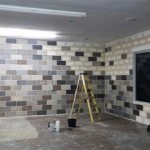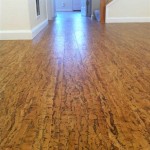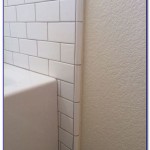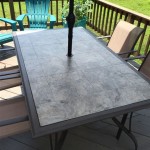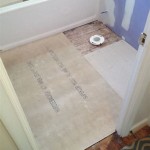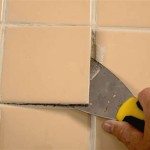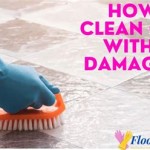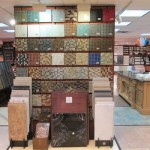Do You Need Backer Board For Shower Wall Tile?
The installation of tile in a shower requires careful consideration of the substrate, the material upon which the tile is adhered. Choosing the appropriate substrate is crucial for the longevity and water resistance of the tiled shower. Backer board, specifically designed for wet environments, is a common choice, but understanding its necessity and proper application is essential.
The primary function of a shower wall is to prevent water from penetrating the structure behind it. This is achieved through a multi-layered system composed of the tile, grout, thin-set mortar, and the substrate. If water infiltrates this system, it can lead to mold growth, structural damage, and costly repairs. The substrate plays a vital role in providing a stable, waterproof barrier.
Traditionally, materials like gypsum board (drywall) were used as shower wall substrates. However, standard gypsum board is highly susceptible to water damage. When exposed to moisture, it deteriorates, loses its structural integrity, and becomes an ideal breeding ground for mold. Consequently, using standard drywall behind shower tile is generally not recommended and often violates building codes.
Backer board, on the other hand, is specifically formulated to withstand prolonged exposure to moisture. It offers a stable and durable surface for tile adhesion. There are several types of backer board available, each with its own properties and applications. Understanding the distinctions between these types is important for selecting the appropriate option for a given shower installation.
Cement board is one of the most common types of backer board. It is composed of cement, reinforced with fiberglass mesh. Cement board is highly resistant to water damage, mold growth, and impact. It provides an excellent bonding surface for tile and is suitable for both shower walls and floors. Cement board requires proper installation, including taping and mudding the seams, to create a waterproof barrier.
Fiberglass-reinforced gypsum panels are another type of backer board. These panels consist of a gypsum core encased in fiberglass mesh. They offer improved moisture resistance compared to standard gypsum board but may not be as durable as cement board in consistently wet environments. These panels are lighter than cement board, making them easier to handle and install. However, they still require proper sealing of the seams to prevent water penetration.
Foam backer board is a relatively newer option. It is composed of a closed-cell foam core coated with a cementitious surface. Foam backer board is lightweight, waterproof, and easy to cut. It also provides insulation, which can help reduce heat loss in the shower. However, it may not be as rigid as cement board and may require additional support in certain applications.
Regardless of the type of backer board chosen, proper installation is crucial. This includes adhering the backer board to the studs with screws, taping and mudding the seams with a waterproof compound, and applying a waterproofing membrane, if necessary. Failure to properly install the backer board can compromise its water resistance and lead to water damage.
Key Considerations for Choosing Backer Board
When selecting backer board for a shower wall, several factors should be considered. These include the expected level of water exposure, the type of tile being used, the structural requirements of the wall, and the installer's experience. Understanding these factors will help ensure that the chosen backer board is appropriate for the specific application.
The level of water exposure is a primary consideration. Showers with high water flow or frequent use require a more robust backer board option. Cement board is generally recommended for these applications due to its superior water resistance. For showers with lower water exposure, fiberglass-reinforced gypsum panels or foam backer board may be suitable alternatives.
The type of tile being used can also influence the choice of backer board. Larger, heavier tiles require a more rigid substrate to prevent cracking and movement. Cement board is typically the best choice for heavy tiles due to its strength and stability. Smaller, lighter tiles may be compatible with other types of backer board.
The structural requirements of the wall should also be taken into account. Walls that are not perfectly plumb or that have uneven studs may require a thicker or more rigid backer board to provide a level and stable surface for tile installation. Cement board is often preferred in these situations due to its ability to span minor imperfections.
The installer's experience can also play a role in the selection of backer board. Some types of backer board are easier to install than others. For example, foam backer board is lightweight and easy to cut, making it a good choice for DIY projects. Cement board, on the other hand, can be more challenging to install due to its weight and the need for specialized tools. Therefore, it is essential to consider the installer's skill level when choosing backer board.
The Importance of Waterproofing
While backer board is designed to resist water damage, it is not inherently waterproof. Therefore, it is essential to incorporate a waterproofing system into the shower wall assembly. This typically involves applying a waterproof membrane over the backer board. The membrane creates a continuous barrier that prevents water from penetrating the substrate.
There are several types of waterproofing membranes available, including liquid-applied membranes, sheet membranes, and integrated systems. Liquid-applied membranes are applied with a brush or roller and create a seamless waterproof barrier. Sheet membranes are pre-fabricated sheets that are adhered to the backer board. Integrated systems combine the backer board and waterproofing membrane into a single product.
Liquid-applied membranes are a popular choice due to their versatility and ease of application. They can be applied to complex shapes and surfaces, and they provide excellent coverage. However, they require careful application to ensure a uniform thickness and coverage. It is critical to follow the manufacturer's instructions carefully to ensure proper waterproofing.
Sheet membranes offer a more consistent thickness and coverage compared to liquid-applied membranes. They are also easier to install in some cases. However, they may be more difficult to apply to complex shapes and surfaces. It is important to properly overlap and seal the seams between the sheets to prevent water penetration.
Integrated systems offer the convenience of a single product that combines the backer board and waterproofing membrane. They are typically more expensive than separate backer board and membrane systems. However, they can save time and effort during installation. It is important to choose an integrated system that is compatible with the type of tile being used.
In addition to a waterproofing membrane, it is also important to properly seal the seams and corners of the shower enclosure. This can be achieved with a waterproof sealant or caulk. The sealant or caulk should be applied to all joints, including the corners of the shower pan, the wall-to-wall joints, and the wall-to-ceiling joints. Regular inspection and maintenance of the sealant or caulk are essential to prevent water leaks.
Alternatives to Traditional Backer Board
While backer board is the most common substrate for shower wall tile, there are alternative options available. These alternatives may be suitable for certain applications or offer specific advantages over traditional backer board. Understanding these options can provide more flexibility in shower construction.
One alternative is a waterproof shower system. These systems typically consist of pre-fabricated shower pans and wall panels that are designed to be completely waterproof. They eliminate the need for traditional backer board and waterproofing membranes. Waterproof shower systems can save time and effort during installation, and they offer a high level of water protection.
Another alternative is a mortar bed. A mortar bed is a thick layer of mortar that is applied to the studs and provides a stable and waterproof base for tile. Mortar beds are typically used for shower floors, but they can also be used for shower walls. Mortar beds require specialized skills and knowledge to install properly, but they can provide a very durable and long-lasting shower enclosure.
A third alternative is a specialized waterproofing compound applied directly to studs or existing wall surfaces. These compounds form a barrier of protection when properly applied. The compound should be designed for this specific purpose and recommended for shower applications.
The choice between backer board and its alternatives depends on factors such as cost, complexity, and desired performance. Backer board with a waterproofing system offers a balance of affordability, ease of installation, and water protection. Waterproof shower systems provide the highest level of water protection but may be more expensive. Mortar beds offer exceptional durability but require specialized skills. Ultimately, the best choice depends on the specific needs and preferences of the project.

Tile Backerboard Material Options Fine Homebuilding

Installing Cement Board In The Bathroom Angie S Roost
How To Install Shower Backerboard Hardieboard Cement Proper Installation Diy

Installing Cement Board In The Bathroom Angie S Roost

Tile Backer Board Installation Key Steps For A Quality Armchair Builder Blog Build Renovate Repair Your Own Home Save Money As An Owner

How To Install Cement Board For Tile Projects Diy Family Handyman

Drywall To Backerboard Transition In Tiled Showers The Floor Elf

Everbilt 32 In X 4 Ft 1 2 Xps Foam Waterproof Backer Board Underlayment For Wall Tile And Stone 5 Pack 41279 The Home Depot

Demo Day And Tile Backer Installation One Room Challenge The Inspired Hive

Installing Cement Board In The Bathroom Angie S Roost
Related Posts

